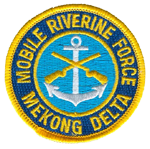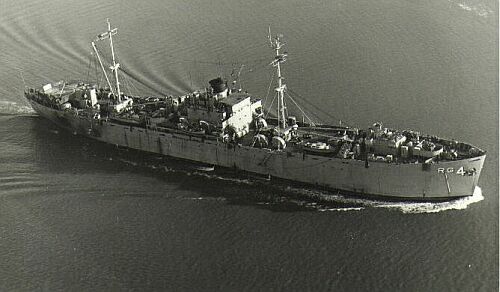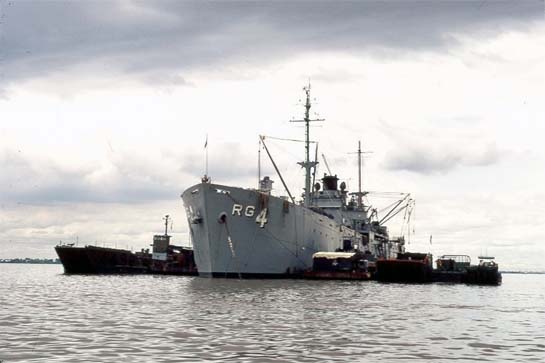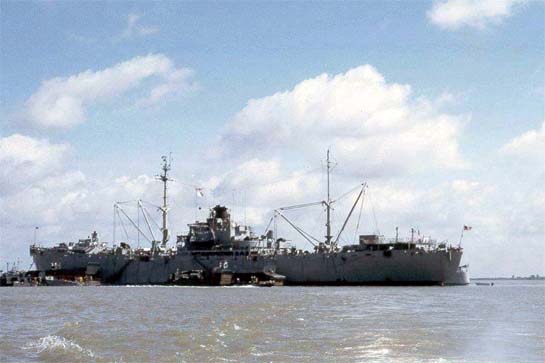
History of The USS Tutuila (ARG-4)
![]()
Arthur P. Gorman was laid down under a Maritime Commission contract (MC hull 1179) on 11 August 1943 at Baltimore, Md., by the Bethlehem Steel Co., renamed USS Tutuila on 8 September and designated ARG-4 launched on 12 September; transferred to the Navy when 80 percent complete for conversion to an internal combustion engine repair ship on 18 September, converted by the Maryland Drydock Co., and commissioned there on 8 April 1944, Comdr. George T. Boldizsar in command.
Tutuila underwent shakedown in Hampton Roads from 20 April to 24 May before sailing for the Panama Canal and proceeding via San Diego, Pearl Harbor, and Eniwetok to the South Pacific.
Early in August, the repair ship joined Service Squadron (ServRon) 10 based at Purvis Bay, in the once hotly contested Solomon Islands. Tutuila served the Fleet as a floating advance base as it swept its way across the Pacific toward Japan. For the final year of the war, the repair ship engaged in round-the-clock work schedules which seldom slackened.
Tutuila aided in the build up for the operations which led to the liberation of the Philippines from the Japanese yoke. Upon completion of this campaign, American task forces set their sights on islands closer to the Japanese homeland. Iwo Jima and Okinawa fell to the telling power of American shells, bombs, and troops which stormed ashore supported by a great Allied armada. Soon, the Allied navies were within shelling distance of the Japanese home islands themselves.
During this time, the repair ship operated first out of Manus, in the Admiralties, before moving to Ulithi in the Carolines. In the wake of the liberation of the Philippines, Tutuila arrived at Leyte on 24 May 1945 and provided repair services there to a wide variety of ships and smaller craft from the date of her arrival until the end of hostilities.
Yet, Tutuila’s work was far from over. As American and Allied forces prepared for occupation of the Japanese homeland, the ship joined those forces headed north for duty off Nippon’s shores. On 30 August, Tutuila (in company with Jason (ARH 1), Whitney (AD-4) and 11 smaller ships) set out on the first leg of the voyage northward. One day out, a typhoon lashed at the convoy, forcing the slower repair ship to remain with the “small boys” while Jason and Whitney received orders to run for Japan. On 2 September, having weathered the storm and shepherded her charges to safe harbor, Tutuila dropped anchor in Buckner Bay, Okinawa.
From there, Tutuila proceeded with a 33-ship convoy, bound for Korea, making port at Jinsen (now called Inchon) on 24 September 1946. She operated there as a maintenance vessel for ships engaged in the repatriation of Japanese prisoners of war. She continued this work after moving to Taku, China, where she arrived on 26 January 1946.
Departing Taku on 30 March, the ship steamed to Shanghai, China, where she dropped anchor on 2 April. Six days later, she sailed for the United States. The ship transited the Panama Canal and arrived at New Orleans on 20 May. Following repairs, she moved to Galveston, Tex., on 9 June 1946 for deactivation and was decommissioned there six months later, on 7 December 1946.
She lay basking in the Texas sun until the summer of 1950, when North Korean troops crossed the 38th parallel and invaded South Korea. As the United States armed forces mobilized to support the United Nations effort, Tutuila received the call to return to active service. Towed to Orange, Tex., she was reconditioned with new shop machinery which replaced her 5-inch and 40-millimeter guns and their magazines. On 7 May 1951 the ship was re-commissioned and assigned to the Service Force, Atlantic Fleet.
Tutuila arrived at Norfolk on 30 May 1951 and served there until 13 October, when she proceeded to Baltimore for one week before returning to Hampton Roads where she remained from 23 October 1951 to 16 June 1952.
Calling briefly at Guantanamo Bay, Cuba, from 20 to 23 June, she operated out of Norfolk again from 28 June to 15 August and from 22 August to 30 October, with a stint at New York in between. She continued this routine of east coast operations from 1952 through 1957, with occasional calls at Port-au-Prince, Haiti; Havana, Cuba; and Guantanamo Bay.
In 1957, the ship paid good will calls to Bermuda in June and Nova Scotia in August, with groups of Explorer Scouts embarked for each cruise. In October 1958, Tutuila again visited Havana and then proceeded to Philadelphia, where she took part in a special project for reclaiming materiel from ships in reserve before returning to Norfolk. She underwent a major overhaul at the Norfolk Navy Yard from 31 October 1958 to 21 January 1959 before proceeding to Guantanamo Bay late in March. But for a round-trip cruise to Port-au-Prince from 10 to 12 April, the ship served there until summer when she returned to the Virginia capes for antisubmarine exercises. The ship continued her operations out of Norfolk until the autumn of 1962.
On one occasion, the repair ship encountered merchantman SS William Johnson in distress while en route to Norfolk and, within a short time, Tutuila sent over a repair crew to correct the engineering casualty.
American reconnaissance planes flying over Cuba in the fall of 1962 noticed unusual activities there, and, when photographic prints were developed, the unusual items and activities were found to be Russian-built missiles and missile sites. In reaction to this threat President John F. Kennedy ordered the Navy to throw a cordon around Cuba, instituting a “quarantine” of the island. In this tense climate, Navy destroyers and patrol planes formed a picket line, turning back Russian ships carrying missiles.
Tutuila proceeded to Morehead City, N.C., where she rendered services before stopping at Norfolk to load cargo and proceed south to support the quarantine line. Basing out of Roosevelt Roads and Vieques, Puerto Rico, the ship provided supplies and services for the ships engaged in blockading Cuban sea lanes.
After the Soviet Government complied with President Kennedy’s demand for the withdrawal of the missiles and all of their associated technicians, sites, and the like, tensions eased. Tutuila proceeded north toward Norfolk but encountered a storm (much like the one weathered in 1945, with 80-knot winds and heavy seas) which caused a three-day delay in her returning to home port.
Operating out of Norfolk and Charleston, S.C., through 1964, the ship provided repair services during Operation “Springboard” in January of 1965. Visits to San Juan and Roosevelt Roads, Puerto Rico, Frederiksted and St. Croix, in the American Virgin Islands; and Fort Lauderdale, Fla.; provided the crew with sightseeing and recreational activities in between her regular duties out of the east coast ports of Norfolk and Charleston. In March 1965, Tutuila participated in a program to reclaim materiel and special equipment installed on radar picket destroyers which were currently being decommissioned at Bayonne, N.J.
As flagship of ServRon 4, Tutuila returned to Norfolk before heading south to the strife-torn Dominican Republic. While performing repair and support duties during the months of April and May, the ship conducted a special series of operations geared toward supplying needed petroleum products to light and power facilities in Santo Domingo after rebel gunfire had prevented normal tanker deliveries
For the remainder of the year 1965, she continued operations out of Norfolk following the Dominican intervention, calling at San Juan and Guantanamo Bay for refresher training after her annual Portsmouth overhaul. During March and April 1966, Tutuila underwent extensive preparation for overseas deployment, as repair shops, berthing and messing spaces were air conditioned, and new communications equipment was procured and installed.
The repair ship sailed from Norfolk on 9 May and transited the Panama Canal on 18 May. After brief stops at Pearl Harbor and at Subic Bay in the Philippines, the repair ship arrived at An Thoi, Phu Quoc Island, in the Gulf of Siam, to support Operation “Market Time” off the coast of South Vietnam.
Relieving Krishna (APL-28) on 19 July, Tutuila commenced servicing the nimble and hard-hitting PCF’s, or “Swift” boats, attached to Division 11. WPB’s of the Coast Guard’s Division 11 were based on Tutuila as well. The following month found Tutuila’s LCM’s and their crews participating in Operation “Seamount,” an Army directed landing operation to clear the southern Phu Quoc Island of enemy forces. Landing South Vietnamese troops at four locations, Tutuila’s boats also carried supplies and ammunition to the Allied ground forces while helicopters evacuated casualties to the repair ship for medical attention.
Krishna returned to An Thoi on 8 October to relieve Tutuila, which then steamed to Bangkok, Thailand, for rest and relaxation for her crew. The repair ship then arrived back off the Vietnamese coast, reaching Vung Tau, off Cape St. Jacques, on 18 October. Here she supported Operations “Market Time”, “Game Warden”, and “Stable Door” through the end of 1966.
The opening days of the new year, 1967, saw the repair ship taking up support duties for the Mobile Riverine Force established at Vung Tau for operations in the Mekong Delta. Here, she assisted in the preparation of ASPB’s and other small patrol craft until USS Askari (APL-30) arrived and took over the major repair and maintenance work.
Tutuila conducted in-country availability for the first time on Hisser (DER-100) on 9 January. Her repair crews finished another difficult job in just five days; the overhauling and repairing of the troublesome diesel generators of USS Benewah (APB 35).
Turned over to the operational control of Commander, Naval Support Activity, Saigon, in April 1967, the ship commenced services to LST’s engaged in operations off the mouth of the Mekong River. During this period, the repair ship continued to provide support and maintenance facilities for craft of the Mobile Riverine Assault Force and supported Coastal Division 13 as well. Further, Tutuila’s 3-inch guns spoke in anger for the first time in the Vietnam conflict, as the ship undertook a shore bombardment in the Rung Sat Special Zone, providing harassment and interdiction fire into an area of suspected Viet Cong activity north of Vung Tau.
Returning to An Thoi in October 1967, Tutuila relieved Krishna and provided support for coastal divisions of Navy and Coast Guard before proceeding to Kaoshiung, Taiwan, for five days of upkeep in late November. She returned to Vung Tau on 7 December to continue supporting coastal interdiction operations.
The repair ship remained at Vung Tau until taking over duties at An Thoi in April 1968 from Krishna. While remaining on station through the summer Tutuila also trained South Vietnamese sailors in the operation of PCF’s, four of which had been transferred to the Republic of Vietnam in August. Tutuila’s hard work earned the Navy Unit Commendation as a result of the labors conducted at both Vung Tau and An Thoi.
Extensive improvements in habitability highlighted the yard work conducted at Yokosuka in January 1969, while the main engine, auxiliary pumps, and the three main generators were all subjected to thorough overhauling. On 21 March, the ship departed from Yokosuka for sea trials and refresher training, a virtually new ship both inside and out. The final week of training completed by 22 April, Tutuila cleared the Japanese isles on the 27th, bound, once more, for Vietnam.
After a five-day visit to Hong Kong en route, the ship dropped anchor at Vung Tau on 14 May. She commenced work almost immediately, conducting a temporary availability on Brule (AKL-28) before 1 June and filling 36 work requests from Mark (AKL-12) as well as repair work and availability requirements for local YFR craft and the Republic of Korea LSM-610.
On 12 June, Tutuila got underway for An Thoi where she supported the continuation of “Market Time,” as well as “SEAFLOAT” and “SEALORDS,” while maintaining PCF’s, YFU’s, APUBI, and several LST’s.
For the months of June and July, the ship also undertook further training operations; repairing 17 Vietnamese Navy PCF’s and training 39 Vietnamese blue jackets in diesel engine overhaul. Saint Francis River (LSMR-525) underwent two weeks of restricted availability, adding to the repair ship’s already busy and round-the-clock schedule. Fulfilling these and other requests for South Vietnamese, Korean, Thai, and United States Navy units, Tutuila remained busy for the remainder of her active career off Vietnam; receiving three Navy Unit Commendations in the process. Late in 1971, she was selected for transfer to the Republic of China Navy.
On New Year’s Day 1972, Tutuila departed Vung Tau after six years of combat support duties. Many times she had hoisted PCF’s or other patrol craft onto pontoons alongside for complete overhauls; her crew had taught their Vietnamese counterparts the intricacies of diesel power plants and generators. Her guns had even conducted one offensive shore bombardment. Vietnam lay behind her as she headed for Hong Kong on 1 January 1972. Six days of bad weather jostled her before she finally made port at the British Crown Colony on 7 January.
Her stay at Hong Kong was not all rest and relaxation, however, as much lay ahead to be done in preparation for the transfer to the Chinese Navy. Tutuila’s crew gave her a “face lift” which included painting, overhauling engines, and getting her records and accounts in order. She departed Hong Kong on 13 January and arrived at Subic Bay two days later, where upon arrival, the work of off-loading supplies and ammunition began.
Departing Subic Bay on 29 January, Tutuila made port at Kaoshiung on 2 February to the accompaniment of a Chinese military band which played tunes from the dockside. For the next three weeks, final checks were undertaken to put the finishing touches on the transfer. Finally, by 21 February 1972, all was in readiness. On that day, Tutuila was decommissioned and struck from the Navy list. Transferred to the Nationalist Chinese Navy, she was renamed Pien Tai and serves as a supply ship into 1979.
Tutuila received (7) Battle Stars, (3) Navy Unit Commendations, and for her Vietnam service.
Awards earned during the Vietnam War: (3) Navy Unit Commendations, Meritorious Unit Commendation, RVN Gallantry Cross with Palm, RVN Civil Action Medal, First Class, with Palm, RVN Campaign Medal with 60’s device and (7) Battle Stars for her Vietnam Service Medal.
![]()
Crewmember Larry Maust reports these additions and corrections to the above:
“Just wanted to correct some things about the History of the USS Tutuila, I was aboard her from about the beginning of 1970 until she was turned over to the Chinese at Kaoshiung in 1971. All the time I was aboard except for when I came aboard in Japan and a few R&R trips the Tutuila was stationed in Nha Be. Your history does not indicate that for almost 2 years she sat in the river there.”
Crewmember Ralph Cooke (RM3) shares the following memories of the Tutuila towards the end of WWII and shortly after:
Friends,
I boarded the USS Tutuila on December 4, 1945 at Taku. I was a Seaman First Class and made Radioman Third Class in early 1946.
On March 30 1946 we left Taku for Shanghai to take on stores before crossing the Pacific to go through the Panama Canal. On this trip we had a little scare when it was thought we sighted a floating mine. We were on alert status but nothing developed.
We pulled liberty in Shanghai in the days of April 4-7, 1946. On April 8 we started out the Yangtze River and on our way across the ocean. The voyage was without incident but did encounter heavy seas at times. I think our top speed was 11.2 knots so we were thirty three days in arriving at the Panama Canal. We went through the Canal on May 11. Our captain had us dressed in our whites and standing at attention as we moved through the canal.
We had some days of liberty in the Canal Zone from Balboa on the Atlantic side until May 15 when we set sail for New Orleans. We arrive in New Orleans on May 20, 1946. This is the last entry on my personal log.
I know following our time in New Orleans we went to Houston where the Tutuila was in dry-dock. Following this we moved on to Orange, Texas where we put her in “mothballs.”
From there I was sent to St. Louis, Missouri where I was discharged from the Navy on July 23, 1946. My tour of duty was eighteen months and 15 days. I spent my 18th birthday in Pearl Harbor aboard the USS Robin Doncaster which we rode from SF Treasure Island to Okinawa with two breakdowns at sea. We stayed three weeks in Pearl Harbor for repairs and in so doing missed that terrible typhoon that tore up so many places in October of 1945. We moved from Okinawa on the USS Magoffin to Shanghai. I was aboard the USS Ankares, a cargo ship, which took us to Taku where I boarded the USS Tutuila as a radioman, SFC.
Some of the men on the crew had been aboard the Tutuila from the time it followed the invasions in the Solomon Islands all the way up through the Philippines and until the end of the war when the ship was sent to Taku to service the LCI’s, LCM’s and LST’s and any other diesel powered crafts.
I remember Christmas Day, 1945. I came topside for a breath of fresh air and an LST was tied up alongside. It was filled with Japanese soldiers and their families who were being repatriated back to Japan from China. It was a sight still vivid in my memory.
Thanks for your work on this site. I will need to spend more time looking it over. I never knew the ship was re-commissioned in 1951 to engage in other service.
I am a retired minister after 52 years of work and am presently at home in Norfolk, Nebraska where we have lived for over six years to be close to my wife’s mother who is now 103 years of age.
Thanks and the Lord bless you,
Ralph E. Cooke, USN 317 32 10, January 10, 1945 to July 23, 1946
Chambers, Nebraska – Home at time of naval service.
Here are two more photos of the USS Tutuila submitted by Jim Bandy. They show the ship located a Nha Be:



